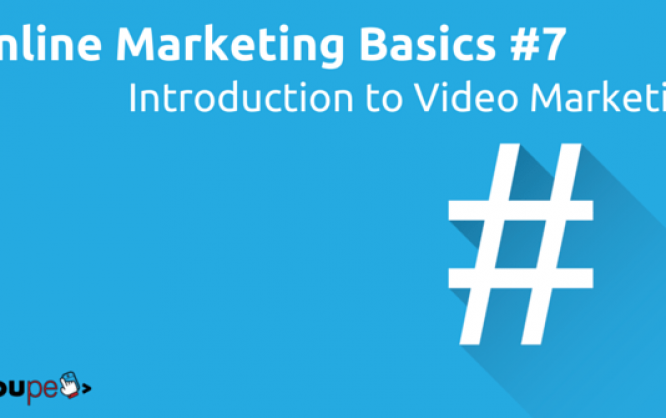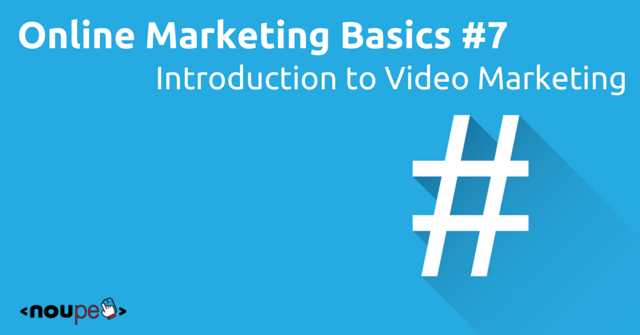Online Marketing Basics #7: Introduction to Video Marketing

Welcome to part 7 of our Online Marketing series that will cover online video marketing. We will not discuss how to shoot a viral video but rather how online video marketing works and how best to approach it, complete with some general ideas and tips.
 We have seen advertising or marketing video spots on TV and movie screens for decades. But the scope of the internet, especially the rise of the social networks, has increased the possibilities for video marketing dramatically. Nowadays, instead of cool TV spots it’s viral online videos that become watercooler talk (a notable exception being the Super Bowl commercials.)
As an entrepreneur you could have many kinds of video produced: promotional videos, image films, corporate films, training videos, product features, tutorials and many more. Professional videos captivate the viewer with a high-quality mix of information and emotion – reflecting well on your brand and your offers.
We have seen advertising or marketing video spots on TV and movie screens for decades. But the scope of the internet, especially the rise of the social networks, has increased the possibilities for video marketing dramatically. Nowadays, instead of cool TV spots it’s viral online videos that become watercooler talk (a notable exception being the Super Bowl commercials.)
As an entrepreneur you could have many kinds of video produced: promotional videos, image films, corporate films, training videos, product features, tutorials and many more. Professional videos captivate the viewer with a high-quality mix of information and emotion – reflecting well on your brand and your offers.
 Another nice example of humour done right is Epuron’s video about wind energy:
You might do without a professional producer if the focus is not on emotions but on informational value, like in How-to-guides or tutorials. The usefulness of such content is certainly a reason why YouTube has turned into the second biggest search engine there is. If you want to learn some new Photoshop shortcut you can simply watch a pro doing it and recreate their steps. Like here:
But don’t get fooled by the overload of video content for webworkers. Information-based content can also benefit other industries. Whenever there is something to explain – there could be a video showing „how to do it“. Want to know how to change a bicycle tube? Here you are:
Tip: The good old online marketing wisdom of content being king also applies to videos. So, additional to a well-structured video production you also have to come up with a catchy, significant title. It will decide whether the user will watch your video, or another one.
Another nice example of humour done right is Epuron’s video about wind energy:
You might do without a professional producer if the focus is not on emotions but on informational value, like in How-to-guides or tutorials. The usefulness of such content is certainly a reason why YouTube has turned into the second biggest search engine there is. If you want to learn some new Photoshop shortcut you can simply watch a pro doing it and recreate their steps. Like here:
But don’t get fooled by the overload of video content for webworkers. Information-based content can also benefit other industries. Whenever there is something to explain – there could be a video showing „how to do it“. Want to know how to change a bicycle tube? Here you are:
Tip: The good old online marketing wisdom of content being king also applies to videos. So, additional to a well-structured video production you also have to come up with a catchy, significant title. It will decide whether the user will watch your video, or another one.
 We have seen advertising or marketing video spots on TV and movie screens for decades. But the scope of the internet, especially the rise of the social networks, has increased the possibilities for video marketing dramatically. Nowadays, instead of cool TV spots it’s viral online videos that become watercooler talk (a notable exception being the Super Bowl commercials.)
As an entrepreneur you could have many kinds of video produced: promotional videos, image films, corporate films, training videos, product features, tutorials and many more. Professional videos captivate the viewer with a high-quality mix of information and emotion – reflecting well on your brand and your offers.
We have seen advertising or marketing video spots on TV and movie screens for decades. But the scope of the internet, especially the rise of the social networks, has increased the possibilities for video marketing dramatically. Nowadays, instead of cool TV spots it’s viral online videos that become watercooler talk (a notable exception being the Super Bowl commercials.)
As an entrepreneur you could have many kinds of video produced: promotional videos, image films, corporate films, training videos, product features, tutorials and many more. Professional videos captivate the viewer with a high-quality mix of information and emotion – reflecting well on your brand and your offers.
What is Online Video Marketing?
Online video marketing distributes videos on the internet to spread or support PR, marketing or sales messages. You could, for example, upload a video to as many platforms as possible to reach as many people from your target group as possible. For instance, a product commercial should aim to trigger a buying impulse and direct a prospective customer to your website. But this is just one way to use it, the tool has much more to offer. A well-done, massively viral video increases brand awareness, it can reflect positively on your image, it can increase customer loyalty, etc. You can directly measure some direct effects of online video marketing: more traffic on your website (the main goal of most of the successful online marketing campaigns), an extended time spent by visitors on your site, or customer retention.The Basic Types of Online Video Marketing
Based on the goals you want to achieve there are two basic types of online video marketing: 1. video content you produced yourself and 2. embedded video produced by others. Self-produced videos can be commercials that are shown at the beginning of (or in between) another video or content that you distribute yourself, hoping it will go viral. Sometimes it could work both ways: initially you place your video as an ad, and afterwards the web embraces it and shares it frantically. Animated commercials are more cost-effective than the live-action ones. Think about that the next time you are looking to promote your products. If you just want visitors to spend more time on your website you don’t have to shoot the video on your own at all. When selling a product at your webshop, for instance, you could just embed a product video by the manufacturer explaining the use and advantages of the product. The same applies to information and news gathering websites. Like, at noupe.com we use 3rd party video content regularly to enhance the user experience and the benefit for the user.Why is Online Video Marketing So Big?
Truth be told, you can be successfully driving traffic to your website without doing online video marketing. There are other marketing tools that might be very useful for some to generate a sustained high level of traffic, sparing them the need to think about video at all. Many use Google as the primary driver for their website traffic. And, of course, producing high-quality video content often means some high up-front costs... However, if you think video might be a useful way to approach your target group, you should consider two things:- Google’s search results: more and more videos appear at the first results pages
- YouTube is already the second largest search engine with 4 billion page impressions per day (2012). Many user search for information and solutions there, like How-to-guides or tutorials.
Which Platform is the Right One for You?
YouTube is by far the world’s biggest video platform. So you could just as well say it’s the most important platform for doing online video marketing. There are different options, though. Choosing them carefully could help you being successful with your marketing efforts. Above all, you should have a look at the respective target groups. Here’s a short (and far from being exhaustive) list of contestants:- Vimeo: Vimeo is more about high-quality content than YouTube. While it’s expanding in scope nowadays, it started as a platform for artists and designers who often upload elaborate production pieces or animated art.
- DailyMotion: Based in France, it’s getting a foothold in other markets, like Germany. There, you will find professional stuff side by side with user-generated content.
- MyVideo and Clipfish are owned by German TV companies (ProSiebenSat1 group and RTL, respectively). Everyone can upload videos there, but user-generated content gets overlooked quickly beside the huge pile of professional TV series. The latter get promoted a lot by their owner companies which in turn means users are more inclined to search only for this kind of content there.
A Fine Line Between Hit or Miss
Depending on your specific goals, you should consider hiring a pro for your video production needs. Stop thinking „Come on, it will run on the internet only“. Low-quality just looks unprofessional and in turn reflects on your business. Other companies learnt it the hard way, after all, getting ridiculed by a mass audience because of some awkward content that was meant to be serious and professional. You certainly don’t want to go there. By the way, even if hiring a professional producer you should still use some common sense to judge the outcome. Before publishing it. Failing to do so can backfire faster than you can say „online video bummer“. As demonstrated by some recruiting videos gone bad, listed by German news magazine „Der Spiegel“ in 2012. As an example, this is what BMW had to say:Which Video Content Gets Users Hooked?
Obviously, image films, corporate video or commercials should all look very professional. The film director has to be able to convey emotions that support your communication goals and click with the audience at the same time. There are some proven techniques to achieve that. First of all, your video should not function as a cliche-ridden bubble of content – neither visually nor copy-wise. Director Peter Schels did a celebrated parody about this urge for showmanship back in 2013. With a wink, and using a fruit vendor as an example he holds a mirror up to his profession: So, by contrast, how should online video marketing that’s actually working look like? Playing the emotional card can be risky. Consider for instance good old humour. If you nail it you will have your audience wrapped around your finger. One of the most popular YouTube videos from this department was made by the company Tipp-Ex in 2010: „A Hunter Shoots a Bear“. It actually consists of many multiple videos, depending on the interaction with users – made possible by the internet. Of course, it’s a promotion for the actual product. But by generating entertainment value for a mass audience it adds an emotional charge to the brand at the same time. Because of the success, consequentially, the campaign earned a sequel soon after. Have a look: Another nice example of humour done right is Epuron’s video about wind energy:
You might do without a professional producer if the focus is not on emotions but on informational value, like in How-to-guides or tutorials. The usefulness of such content is certainly a reason why YouTube has turned into the second biggest search engine there is. If you want to learn some new Photoshop shortcut you can simply watch a pro doing it and recreate their steps. Like here:
But don’t get fooled by the overload of video content for webworkers. Information-based content can also benefit other industries. Whenever there is something to explain – there could be a video showing „how to do it“. Want to know how to change a bicycle tube? Here you are:
Tip: The good old online marketing wisdom of content being king also applies to videos. So, additional to a well-structured video production you also have to come up with a catchy, significant title. It will decide whether the user will watch your video, or another one.
Another nice example of humour done right is Epuron’s video about wind energy:
You might do without a professional producer if the focus is not on emotions but on informational value, like in How-to-guides or tutorials. The usefulness of such content is certainly a reason why YouTube has turned into the second biggest search engine there is. If you want to learn some new Photoshop shortcut you can simply watch a pro doing it and recreate their steps. Like here:
But don’t get fooled by the overload of video content for webworkers. Information-based content can also benefit other industries. Whenever there is something to explain – there could be a video showing „how to do it“. Want to know how to change a bicycle tube? Here you are:
Tip: The good old online marketing wisdom of content being king also applies to videos. So, additional to a well-structured video production you also have to come up with a catchy, significant title. It will decide whether the user will watch your video, or another one.
What’s Next in our Online Marketing Series?
The next part of the series deals with Affiliate Marketing. We will explain the basics of this tool and discuss who could benefit the most from it. Furthermore, we will present some of the better known affiliate networks.Related links
- Embarassing HR recruiting videos as listed by German news mag "Der Spiegel" in 2012
- The Tools of Online Marketing (Basics #1)
- Online-Marketing-Basics #2: 3 Reasons Why Your Website Should Be at the Top of Your List
- Online Marketing Basics #3: Introduction To Social Media Marketing
- Online Marketing Basics #4: Search Engine Optimization (SEO) for Beginners
- Online Marketing Basics #5: Introduction to Search Engine Advertising (SEA) and How Best to Use it
- Online Marketing Basics #6: Introduction to Email Marketing
